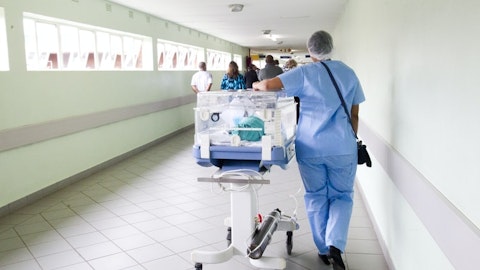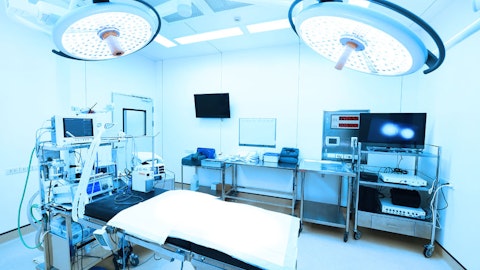Yi Chen: Okay. Got it. And can you provide a rough guidance at this point on how many systems you expect to ship – to be shipped in 2024?
Javier Rampolla: I don’t want to go there. We’re always going to try to push for more, but again, it all depends on how the year works out. I mean, when we started – when we were at this – last year at this time, we were expecting some big things happening in 2023, after such a great fourth quarter as well. But things didn’t turn out that way. Inflation hit really hard. So it makes you worry about predicting things and saying things. We would rather, overachieve and under-commit versus going the other way. We don’t want to disappoint anybody, but I can assure you that everybody in the team is going to work very, very hard, to make sure that we achieve better than what we did the year before.
Yi Chen: Okay. Got it. And shall we expect, the gross margin to improve in 2024 as you place more units under the recurring revenue model?
Javier Rampolla: So I will keep the margins, Yi the way they are right now. We’re basically in – early stage of this program. So I will just keep them the way it is and then we’ll continue to improve as we continue, developing this program.
Yi Chen: Okay. Got it. Thank you.
Javier Rampolla: Thank you, Yi.
Operator: And our next question will come from Anthony Vendetti with Maxim Group. Please go ahead.
Anthony Vendetti: Thanks. Thanks. So, if we could just dig in a little more into the utilization trends that you’re seeing for the systems that you have out there. And do you have a total install base at this point number that you can share? And then just and just an update. I know you’re awaiting FDA approval for your transdermal infusion system. Where is that exactly? And I guess obviously up to the FDA, but what’s your expectation for final approval?
Joe Sardano: Okay. Number one, we have over 750 installations of SRT products around the world. So we’re closing in. Hopefully sometime in this fiscal year we’ll hit 800 and go beyond. We submitted the TDI product in October of 2023. And, you know, I couldn’t predict when the FDA will finally approve it, but we sure would like to get FDA clearance, by the time we get to the AAD in March, the second week in March. If we had that approved, I think that we could start shipping units in April. We’ve begun the process of working with manufacturing, and getting things lined up for that process. So, I think that we’ll be ready to ship in the second quarter of this year, as long as we get FDA clearance in the first quarter.
Anthony Vendetti: Okay. I know that’s great. Any just and type of utilization trends that you’re able to glean from your Sentinel system, or just from what you’re hearing from physicians?
Joe Sardano: Yes. I think that we’re seeing the same as we’ve seen in the past with the 27% increase year-over-year. Clearly the volumes continue to go up. And so, there’s more and more people that are getting their bodies scanned, or whatever for skin cancer, and they seem to be choosing the non-invasive way of being treated. So it’s a fast way. It’s a more productive way. It’s a good cash flow for the doctors. There’s a lot of good points for all of this to happen, and I think that that trend is going to continue to grow, and there’s no question in my mind. As I’ve stated before, that this will sooner or later become the number one choice for the treatment of non-melanoma skin cancer. I think it will be the treatment of choice very, very shortly.
Anthony Vendetti: Okay. Great. And then just lastly, in terms of the recurring model, you know, is there a minimum number of treatments? I know in the fair market lease, it’s relatively – it’s two, two and a half, depending on the interest rate, I guess, treatments per month, or whatever, to just breakeven, which is obviously not a large number. But in terms of how many treatments do they have, to perform in order to get the placement, or is it a placement and it’s just a revenue sharing program?
Joe Sardano: Yes. First of all, although two patients is the approximate breakeven to own a system or to buy a system. There’s not a minimum number of units, or patients that must be delivered with a recurring revenue. But I would tell you that we don’t have any of our customers currently with SRT that do less than 10 patients a month, for the most part. We have some customers that are doing 50 and 60 patients a month. So, we’re seeing some very high volumes at those sites. And so clearly, we’re going to approach the customers, and the customers who are interested in this model, are the ones that know that they have some decent volumes. They’re going to come to us, and we’re going to come to, you know, whatever agreement we’re going to establish.
But clearly, I think the model that we’re going to have. Is that if the doctors do a lot of patients, they’re going to have the ability to keep most of their money. And I think that’s going to be a fair valuation for us, and I think that it’s going to be profitable for us and profitable for them. So, we’re looking forward to introducing this model to them. I think that they’ll agree that this is something that is going to be worthwhile for them to review. But I would also tell you this. If we make 10 presentations to 10 different customers on the recurring revenue model, I’ll bet you five end up buying it anyway.
Anthony Vendetti: Right, right. Okay. Especially as you’re saying that, you know, on average, the physicians that purchase the product see 10 patients a month, and some see many more than that. They may decide the fair market lease, is a better way of going if they are sharing revenue. So. But you’ve giving them the option, which theoretically, for some that are reticent necessarily to either go the lease route or lay out the cash, could increase the adoption rate in 2024?
Michael Sardano: Yes. Additionally, this is Michael, Anthony. How are you?
Anthony Vendetti: Good.
Michael Sardano: Good. Part of this model also is that we’re going to be taking away some of the work from an operations standpoint that go into the practices. So certain practices are actually willing to pay, fast on the outside to supply some personnel that would take away some of the operational work from the practice itself so that they could concentrate on other areas of the business. So, we would be supplying those personnel to then take away that work.
Anthony Vendetti: Okay, interesting. Okay. Great. That’s helpful color. I appreciate it. I’ll hop back in the queue. Thanks.
Michael Sardano: Thanks, Anthony.
Joe Sardano: Thanks Anthony,
Operator: [Operator Instructions] Our next question will come from Ben Haynor with Alliance Global Partners. Please go ahead.
Ben Haynor: Good afternoon, gentlemen. Thanks for taking my questions. Can you hear me okay?
Joe Sardano: Yes, sir.
Michael Sardano: Hi, Ben.
Ben Haynor: Excellent. So just to maybe clarify, how many different components will go into the recurring revenue model? I mean, it sounds like there’s, you know, potential for rental. There’s potential for a click fee. There’s potential for some of the folks that are the personnel that you’re putting on the ground. What could that fee encompass? How does that fee ultimately get put together on the monthly, importantly, or whatever?
Michael Sardano: Yes. Thanks, Ben. This is Michael. Thanks for the question. So there’s really two components to it. There’s the device component, and then there’s the personnel component. So on the device side, it’s simple. It’s the SRT-100 Vision. They utilize it the same way that they would if they purchased it or leased it. And on the personnel side, as I just said to Anthony, we would supply these personnel, mainly a radiation oncologist, an RTT, and a physicist, to do the work that these practices are usually on their own for. So, for instance, if you bought a car, I always just use cars as an example. You’d have to take the car in to Toyota, or what have you and have that fixed. Well, now we’re going to do that for you.



